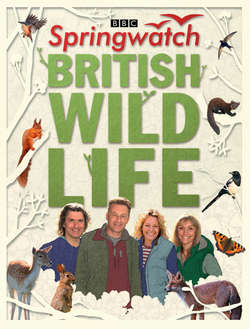Читать книгу Springwatch British Wildlife: Accompanies the BBC 2 TV series - Stephen Moss - Страница 19
ОглавлениеStarling
©John Hawkins/FLPA
Close-up, the starling is one of our most handsome garden birds.
Is there any bird with a more contradictory public image than the starling? Hated and vilified for its supposed ‘bullying’ of other smaller birds on our bird tables, the very same species is celebrated for its extraordinary evening flights during winter, when millions of birds gather together in aerobatic displays before going to roost for the night.
We may try to separate these two images in our mind, but they are just two very different aspects of the lives of this much-maligned yet fascinating bird. Even if you don’t like their behaviour as they squabble around your bird table, just take a moment to have a closer look.
The starling may appear black but its plumage is in fact a subtle mixture of glossy blacks, mauves, greens and browns, which in autumn and winter is heavily spotted with white. In spring and summer, the spots mainly disappear to reveal a truly stunning glossy plumage, set off by that bright yellow, dagger-shaped bill.
In late summer, people are often puzzled when they see birds that, although the size and shape of a starling, are a dull brown in colour. These are juvenile birds, which have recently left the safety of the nest and are hanging around with their parents. They always look rather embarrassed at their drab plumage – as well they might.
Although starlings may have some pretty antisocial habits, they are also fascinating to watch as they jostle for position on a bird table, often uttering little calls as if scolding their companions. In some ways they are a bit like us: sociable, noisy and a bit messy. Perhaps that’s why we view them with a degree of suspicion!
Until quite recently, winter roosts of starlings could be found across much of lowland Britain, sometimes in the middle of the countryside but more often in the heart of city centres, where the extra warmth would attract huge flocks on winter evenings. There were famous roosts in the centre of Glasgow, on Bristol Temple Meads station and in London’s Leicester Square. But during the past two or three decades, numbers have fallen dramatically, and now very few roosts remain – and none in our cities. The best known of today’s roosts, on the Somerset Levels, once attracted as many as seven million starlings. Today, numbers are down to one or two million, but this is still enough to create spectacular aerial displays.
It is often asked how on earth birds in these gatherings avoid crashing into one another as they fly so close and so fast. The simple answer is that they look out for movements of the birds around them, and when one bird shifts position – perhaps in response to a bird of prey such as a sparrowhawk or peregrine – each adjacent bird will follow suit. This creates the most extraordinary twists and turns of the whole flock, as if it were a single organism. Only when a few birds decide to go to roost for the night in the reeds below will the rest follow suit, plummeting towards the ground like water running down a plughole.
There are two possible reasons for the decline in numbers at these winter roosts. One is that the British population has been dropping, as with so many of our countryside birds, due to modern farming methods. Another is that milder winters across continental Europe have meant that many birds stay put instead of crossing the North Sea to Britain.
Starlings have another hidden talent: the ability to mimic not just other birds, but mechanical devices too. So if you hear what sounds like a car alarm or a mobile phone, but can’t work out why the noise is coming from a rooftop, the chances are it is being made by a starling!
©Dickie Duckett/FLPA
The spectacular gatherings of millions of starlings on winter evenings have become a tourist attraction in parts of Britain.
